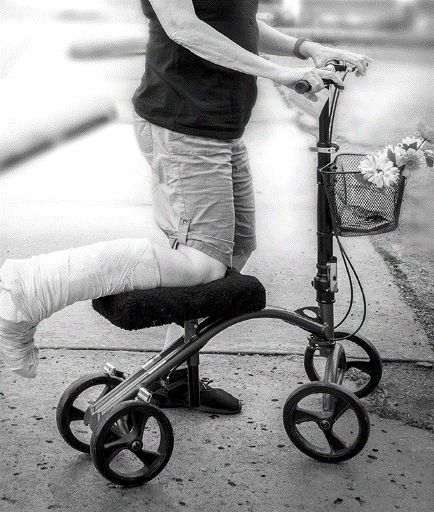Physiotherapy
How to use a knee scooter
Knee scooters are mobility devices. They are designed to help you move around while you recover from a foot, ankle, or leg injury or surgery.
Knee scooters have:
- a padded platform where the injured leg rests, bent at the knee
- handlebars and hand brakes for steering and stopping
- 4 wheels for balance and stability
- a design that makes it easy to move around without using too much of your upper body
A knee scooter is best for short-term use. It can help you keep weight off your foot and ankle on your injured side. You need good strength and control of your non-injured leg to use a knee scooter.
Your healthcare team may have given you specific instructions about how much weight you can put on your injured leg. Follow those instructions closely.
Always read and follow the manufacturer’s instructions that come with your knee scooter.
How to adjust the fit of your knee scooter
Adjusting the height of the knee rest
- Stand beside a sturdy surface, holding on for support as needed.
- Bend the knee of your injured leg 90 degrees.
- Have someone measure the distance from the bottom of your bent knee to the floor.
- Adjust the height of the knee rest to match this distance. Your knee rest is at the right height if your knee is comfortably supported at 90 degrees and your hips are even.

Using a knee scooter
Adjusting the height of the handlebar
- Stand up straight.
- Adjust the handlebars so they are at a comfortable position between your hips and your waist. When you stand up straight and hold the handlebars, you should not be hunched over.
How to get on and off your knee scooter
Getting on your knee scooter
- Make sure the hand brakes are locked.
- Put yourself beside the scooter with your injured leg closest to it.
- Hold on to the handlebars.
- Bend your knee to place your injured leg onto the knee rest. Your knee and the top part of your lower leg should be supported on the pad, while your foot and ankle hang off the back.
- Keep your non-injured leg on the ground next to the knee scooter. Make sure you are stable and balanced before moving.
Getting off your knee scooter
- Once the knee scooter has stopped moving, lock the hand brakes.
- Keep your hands on the handlebars.
- Step off the knee scooter. Follow the instructions from your healthcare team about how much weight you can put on your injured leg.
How to walk with your knee scooter
- Keep your non-injured leg on the ground next to the knee scooter. Make sure you are stable and balanced.
- Unlock the hand brakes.
- Starting with small steps, use your non-injured leg to push yourself and the knee scooter forward.
- Use the hand brakes to slow down and to control your speed.
- To stop, fully apply the hand brakes.
How to turn your knee scooter
- Before you turn, slow down using hand brakes.
- Turn the handlebars to guide the wheels in the direction you would like to go. If the turn is tight, you might need to do a 3-point turn (scooting backward and forward to make the turn). With practice, this should feel easier.
How to go up and down curbs
Going up curbs (ascending)
- Bring the front wheel of your knee scooter to the curb.
- Lean forward over the handlebars as you slowly lift the front 2 wheels onto the curb.
- Move the knee scooter forward and apply the brakes to avoid rolling backward and to keep the knee scooter in place.
- Put your non-injured foot onto the curb.
- Release the brakes and slowly roll the knee scooter forward to bring the back wheels up and onto the curb.
Going down curbs (descending)
- Scoot to the edge of the curb.
- Apply the brakes.
- Lean slightly backward as you slowly bring the front wheels off the curb.
- Step down with your non-injured foot.
- Slowly roll forward to bring the back wheels down off the curb.
Safety tips
- Go slow and stay in control. Do not scoot at high speeds.
- Keep both hands on the handlebars at all times.
- Always slow down before making a turn. Use your brakes to slow yourself down.
- When you are scooting downhill, keep your speed slow and controlled. Use both your handbrakes and your non-injured foot to control your speed. Take small, quick steps with your non-injured leg.
- Always keep your body balanced on your knee scooter.
- If you need to reach out for something, park the knee scooter as close as possible to where you need to reach. Always put on the brakes before reaching. Avoid reaching for things on the floor while you are on your knee scooter.
- Do not use the knee scooter to pull yourself up from a seated position.
- Think about getting a basket to attach to your knee scooter if you think you will need to carry things.
- Assess the terrain you are on and try to avoid steep or uneven ground.
- Do not use your knee scooter on stairs or steps.
- Do not use a knee scooter if you have issues with balance, coordination, or vision, or if your non-injured leg is not strong and healthy.
To learn more about using a knee scooter, watch how to use a knee scooter (video) from the American College of Foot and Ankle Surgeons.
Your doctor or physiotherapist will tell you when you can stop using your knee scooter.
To see this information online and learn more, visit https://MyHealth.Alberta.ca/health/AfterCareInformation/pages/conditions.aspx?hwid=custom.ab_physio_kneescooter_inst.

For 24/7 nurse advice and general health information call Health Link at 811.
Current as of: July 23, 2025
Author: Allied Health Professionals, Alberta Health Services
This material is not a substitute for the advice of a qualified health professional. This material is intended for general information only and is provided on an "as is", "where is" basis. Although reasonable efforts were made to confirm the accuracy of the information, Alberta Health Services does not make any representation or warranty, express, implied or statutory, as to the accuracy, reliability, completeness, applicability or fitness for a particular purpose of such information. Alberta Health Services expressly disclaims all liability for the use of these materials, and for any claims, actions, demands or suits arising from such use.
